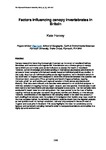Factors influencing canopy invertebrates in Britain
| dc.contributor.author | Harvey, K. | |
| dc.date.accessioned | 2019-05-17T09:04:39Z | |
| dc.date.available | 2019-05-17T09:04:39Z | |
| dc.date.issued | 2015 | |
| dc.identifier.citation |
Harvey, K. (2015) 'Factors influencing canopy invertebrates in Britain', The Plymouth Student Scientist, 8(1), p. 123-157. | en_US |
| dc.identifier.issn | 1754-2383 | |
| dc.identifier.uri | http://hdl.handle.net/10026.1/14088 | |
| dc.description.abstract |
Canopy research is becoming increasingly important as the extent of woodland habitats decreases and becomes more fragmented. Invertebrates are a diverse group of canopy fauna which are commonly used as bio-indicators to assess the health of woodland. However, current knowledge and understanding of invertebrate abundance and diversity in temperate forest canopies is limited and usually based on individual preliminary studies. In this study, data from six individual studies across eight locations, two in Scotland and six in the south-west of England were analysed to determine differences between tree species: oak (Quercus robur), scots pine (Pinus sylvestris) and beech (Fagus sylvatica); trapping methods: pitfall, fan and bubble; and regional variation in invertebrate abundance and diversity. After data were collated, sub-samples were selected to run statistical analyses to minimise variation of trapping method, region, season, and tree species. Invertebrates in oak were found to be more diverse and abundant compared to scots pine. Too few samples were conducted in beech trees for a fair comparison. Fan traps proved to be the most effective trapping methods as samples contained the greatest number and diversity of invertebrates. However, consideration of the objective of the sampling needs to be taken into account; if bark-dwelling invertebrates were the subject of investigation then bubble wrap traps would be the most suitable method. No definitive conclusion could be drawn from the regional analysis as tree species could not be kept consistent, oak was only sampled in the south-west of England and scots pine in Scotland. This study highlights the need for consistency and a rigorous and systematic sampling method in order to compare invertebrate communities in a highly dynamic environment. | en_US |
| dc.language.iso | en | en_US |
| dc.publisher | University of Plymouth | |
| dc.rights | Attribution 3.0 United States | * |
| dc.rights.uri | http://creativecommons.org/licenses/by/3.0/us/ | * |
| dc.subject | canopy | en_US |
| dc.subject | woodland habitats | en_US |
| dc.subject | canopy fauna | en_US |
| dc.subject | bio-indicators | en_US |
| dc.subject | Quercus robur | en_US |
| dc.subject | oak | en_US |
| dc.subject | Scots pine | en_US |
| dc.subject | Pinus sylvestris | en_US |
| dc.subject | beech | en_US |
| dc.subject | Fagus sylvatica | en_US |
| dc.title | Factors influencing canopy invertebrates in Britain | en_US |
| dc.type | Article | |
| plymouth.issue | 1 | |
| plymouth.volume | 8 | |
| plymouth.journal | The Plymouth Student Scientist |



